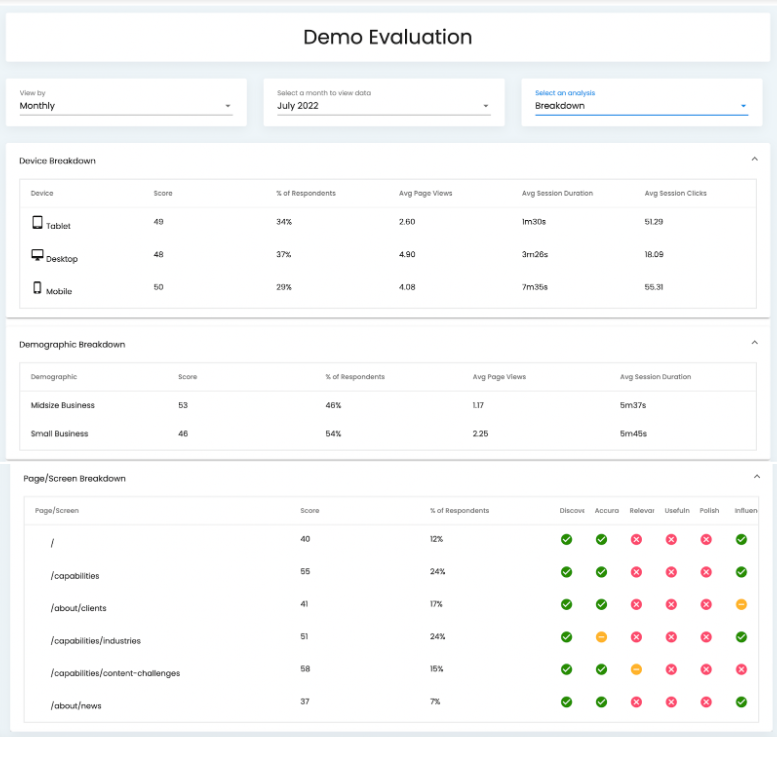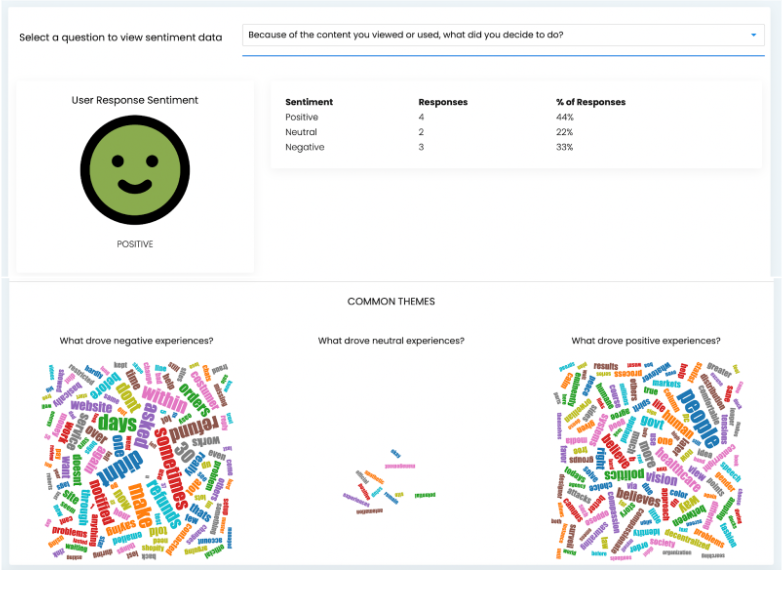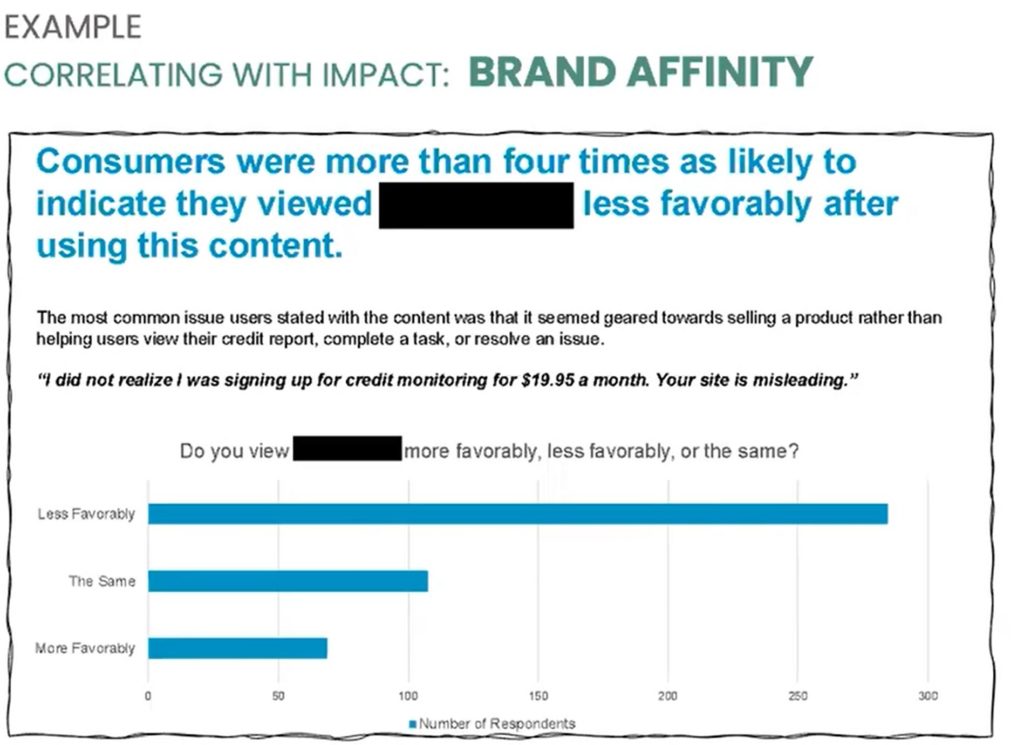
If you want to offer high-quality content at scale, you need to prioritize evaluating content effectiveness. In our ContentWRX webinar, Content Science President Colleen Jones and Senior Analyst Angie Vaughn shared their inside knowledge on connecting data to impact.
Here are seven key takeaways for quick reference.
1. Business Is Digital, So Content Is Critical
Living in the age of content is a fact of business today. To be a great company, nonprofit, or government agency, you need to offer great content.
So what exactly is content effectiveness? Content effectiveness is how well content enables customers or users to achieve their goals, while also achieving your goals.
These insights are based on years of research and we’ve seen them come into play time and time again.
2. Evaluating Content Effectiveness Is Hard
If content effectiveness leads to success, why are only 1 in 3 companies evaluating content effectiveness? Because it’s hard. The key to success is finding that sweet spot of advancing goals while at the same time helping customers. Customer goals might include learning more about a topic, completing a task, or making a decision.
But why is it so hard for companies to measure success? There are several reasons:
- There are too many places where metrics are collected, and it’s hard to know which ones matter most.
- Even if you’re tracking the right metrics, it can be difficult to connect them back to business impact.
- Successful content requires a long-term commitment, but many companies are only interested in short-term results.
- It can be difficult to get executive buy-in for content initiatives because they often require significant upfront investment with no guarantee of an immediate return on investment.
Despite the challenges, evaluating content effectiveness is essential if you want your content efforts to be effective. By understanding what success looks like and tracking the right metrics, you can make sure that your content is having the desired impact and adjust your strategy accordingly.
3. Looking for Quick Wins or Building a Longer-Term Strategy? Benchmark and Compare Your Data
Benchmarking data using the overall content effectiveness score in the ContentWRX dashboard or across the six dimensions of effectiveness allows you to get a more holistic view of your content’s performance.
Once you benchmark, you can build on that with comparisons.
Comparing content performance data is a helpful way to understand how well your content is doing and where there might be room for improvement. A comparison can show how changes in content impact its performance. For example, compare goal completion results across areas of content that are updated with those that aren’t. This comparison could quickly show how your new approach to content is making a difference.
You can also inform content migration planning with benchmarking and comparison data so that your content is as effective as possible. This approach can help you find the immediate needs for each type of content so that you can make informed decisions about where to focus your efforts. Insights from benchmarking and comparison are also useful for longer-term planning around content creation, ideation, and strategy.
4. Challenged With Actionable Content Effectiveness Insights? Get an Automated Breakdown
Oftentimes, when you are struggling to figure out how to take action on content data, it helps to dive deeper. And ContentWRX empowers you to do so. If you want to see how engagement varies by different audiences, break down your content effectiveness data by device, demographic, and screen level.
This a screenshot of the types of data breakdowns you can see in ContentWRX, including by device type and business size.

5. Don’t Know Why A Is Performing Better Than B in Your A/B Testing? Customer Feedback Can Close the Gap
If you have experience with A/B testing, you know that it’s a great way to get insights into how your content is performing. But oftentimes, you don’t know why one element is performing better than another. That’s where ContentWRX comes in.
ContentWRX helps you understand why A is performing better than B. With ContentWRX, you can tie feedback to user IDs and integrate that with A/B testing tools. Doing this allows you to bring in customer feedback around each option that you are testing. This way, you can get a complete picture of how your content is performing and what needs improvement.
The following example shows how Mailchimp used A/B testing to test its pricing page. Mailchimp implemented ContentWRX to understand which page was performing better and why. ContentWRX helped capture such as those below, which helped Mailchimp iterate on its pricing page.

6. Not Sure Why You Are Getting High Bounce Rates or Other Results? Add Context for Insight
Are your bounce rates a good or bad thing? Is one audience more engaged than another? Follow these examples of how Mailchimp and March of Dimes use ContentWRX to add context to help them answer these questions.
Bounce rates can be deceiving. A high bounce rate doesn’t necessarily mean that people are leaving your site because they’re uninterested. Sometimes, it could just mean that they’re not finding what they’re looking for.
For example, Mailchimp had high traffic volume to their knowledge base content, but lacked context for the high bounce rates they were seeing. They looked at the feedback they received with ContentWRX and found that prospective customers were being driven to support content. Customers were interested in learning more about how the product works and what the features are. But they got stuck in the knowledge base, not achieving their goal.
Customer insight helped Mailchimp think more about the buyer journey and what that means for the customer experience. The insight resulted in positive change. The team was confident in making positive changes because they had the data to back up their new approach.
Similarly, March of Dimes is a leader in maternal health education. They found one of their target audiences, people who experienced pregnancy loss or complications, was less engaged on their site than other priority groups, such as their mission-driven audience. We looked closely at how the site served that target audience and drilled down and added more context to understand how content had an impact on different users.
Additionally, you can use sentiment analysis to dig deeper into how users view your content. Sentiment analysis is a process of determining whether users view your content as positive, negative, or neutral.
ContentWRX uses natural language processing (NLP) to automatically analyze sentiment in open-ended user responses. This means that you don’t have to go through each response manually and try to determine the sentiment yourself. Sentiment analysis can be a valuable tool for understanding how audiences receive your content. It can help you identify areas where you might have some opportunities or challenges.

7. If You’re Focused on Business Impact, ContentWRX Can Help You Find Useful Correlations To Help You Achieve Your Goals
As a content professional, it’s important to understand what kind of impact your content is having. ContentWRX makes it faster and easier to get the content effectiveness data that will accelerate finding meaningful correlations that have a business impact.
Whether you are trying to improve search visibility, increase key conversions, drive brand affinity, or grow revenue–the right correlation data will give you a path to better content that will impact these business outcomes.
Tying your content to the desired impact is essential for demonstrating its value to your organization. Fortunately, there are tools like ContentWRX that can help you assemble relevant quotes and data points to get executive attention and create positive change.
In this example from a credit services firm client, Content Science used ContentWRX data to show how consumers who engaged with the firm’s content were four times as likely to indicate that they viewed the brand less favorably after using the content. Content Science pulled in supporting user quotes to highlight the content challenges. Brining this data to the firm’s executives led to positive change in this content.

Want to learn more about evaluating content effectiveness with ContentWRX? Check out our webinar: 5 Ways to Evaluate Content Effectiveness with ContentWRX.
Events, Resources, + More
The Ultimate Guide to End-to-End Content
Discover why + how an end-to-end approach is critical in the age of AI with this comprehensive white paper.
The Content Advantage Book
The much-anticipated third edition of the highly rated book by Colleen Jones is available at book retailers worldwide. Learn more!
20 Signs of a Content Problem in a High-Stakes Initiative
Use this white paper to diagnose the problem so you can achieve the right solution faster.
Upskill with Content Science Academy
Training for modern content roles through on-demand certifications + courses or live workshops.






Comments
We invite you to share your perspective in a constructive way. To comment, please sign in or register. Our moderating team will review all comments and may edit them for clarity. Our team also may delete comments that are off-topic or disrespectful. All postings become the property of
Content Science Review.